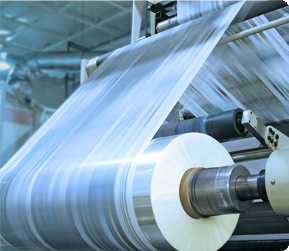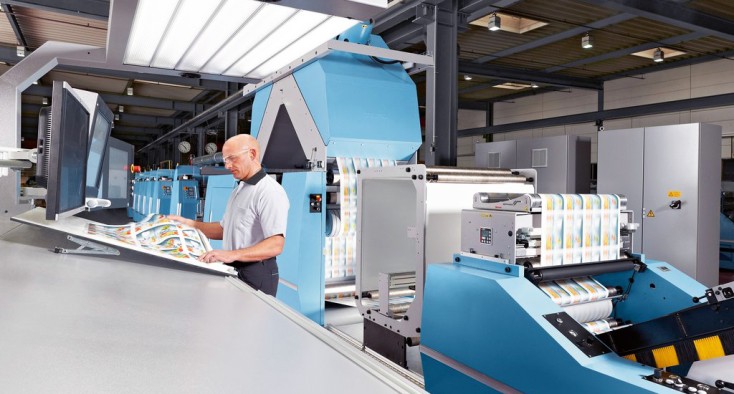Blog

Converting and Printing Industry
Converting and Printing: 70 years of experience in the finishing and processing of paper, film and foil
As one of the leading automation and drives specialists with extensive sector know-how and a worldwide network of experts in the converting and printing industry, we will work with you closely to find the very best solution. Whether you want to improve your existing equipment or develop a new machine, we set your ideas in motion with dedication and enthusiasm.
In line with your individual requirements and ideas, we support you in all aspects of your projects, cooperate with you in their implementation and also help you to implement your overall innovative concepts.
We develop innovations for the converting and printing industry and this is how we do it:
- Experienced experts understand your requirements and goals
- Innovative software and hardware for the implementation of forward-looking solutions
- Reliable drive systems for high system availability
- Use of open standards
- Global production with uniform Lenze quality standards
- Worldwide efficient logistics concept
- Global service network and range of training courses offered
What is Converting?
I know it may sound like a deeply religious experience, but “converting” or “conversion” is really a post-press activity that involves making a flat printed press sheet into a three-dimensional object. For instance, you may convert a flat printed sheet into an envelope, or laminate a flat printed sheet onto paperboard and then cut and fold it into a box. You may even take a flat printed sheet, laminatie it to a light plastic substrate like “Coroplast” and then use a jigsaw to cut and assemble it into a free-standing “point-of purchase” display. This display, for example, might be a superhero stand-up figure with a carrier box for the toys you want to sell.
Several processes come up frequently in describing a conversion: printing a flat sheet, laminating, cutting, folding, assembling, and gluing. Again, you’re starting with a flat printed sheet and turning it into a three-dimensional item.
As mentioned before, this is true when we consider the envelope. The envelope is a little “bag” or “box” of sorts. It’s even referred to as a “carrier” in marketing parlance. An envelope has a front, back, and flap. It is a three-dimensional item.
Boxes and point-of-purchase displays are also similar in some ways. You start with a flat printed sheet, which you then attach to a stronger material (usually either paperboard–also known as chip board–or corrugated board, the kind with little paper fluting between two flat sheets) with some form of hot melt glue. Then you cut out a form. This is known as die-cutting, and it is accomplished on a die-cutting press, which is like a letterpress with a metal cutting rule and no ink units or rollers. The non-essential portions of paper laminated to board are cut away and discarded. Then, the form is folded up and portions are glued together to make a three-dimensional item.
This is really not that different from the way an envelope is created. It is also cut, folded, and glued. However, for the cardboard box (product packaging) and point-of purchase display (the stand up box at the grocery store with the eye-catching graphics and bins to hold “product”), the printed press sheet is first attached to the more durable and rigid substrate that is then die-cut, folded, and glued. With an envelope, you usually just use the printed press sheet with no backing.
So all three items are made in essentially the same way: print, cut, fold, glue.
Why would you convert an envelope when you can just buy a box of blank, pre-made envelopes and print on them? Good question. It certainly is more expensive to convert envelopes. And it takes longer, and not all printers can do it in-house.
When you design an off-size envelope (non-standard), or when you have the graphic images bleeding off the edge of the envelope, you get a much crisper print job and final product if you first print the sheet and then cut and form it (convert it) into an envelope. Actually printing on the envelope is fine if your design is simple, maybe a two-color job, in which ink covers a small area. But if your design uses heavy ink coverage (and particularly if the design covers the seams where the envelope sides are folded and glued), you will be much happier with an envelope that has been printed first and then converted.
How much more does it cost? It costs a lot. If you buy 2,000 envelope blanks and print a two-color creative design on them, you may pay $300.00 to $500.00 for the job. If you print the job and then convert it, you might pay up to $1,000.00 to first print the job on a large, high-quality press. The total cost would probably include an additional $500.00 for the die and then several hundred (or up to a thousand) dollars more for the die-cutting and gluing operations (maybe $2,000.00, or more, total). So it is prudent to only do this when you are producing a long run (20,000-100,000 envelopes) of a high profile marketing job that stands to reap great financial rewards that would justify the expense. It’s not cost effective to design, print, and convert a simple, functional envelope that does not “sell” your company or product.
For the boxes and point-of-purchase displays, the same logic holds true. If you’re producing 500 or 1,000 boxes, it’s much cheaper to print a simple, one- or two-color design directly on flat corrugated board using a flexographic press (rather than on a press sheet that will be laminated to the corrugated board). You could then cut and fold the corrugated sheet into your final box or display. Or you can even buy pre-cut, standard-sized boxes and affix pre-printed crack-and-peel stickers right onto the boxes. That is, you can print a nice four-color image right on sticky-backed paper that you can then peel and affix to the cardboard. This way you’re not paying for a die to cut uniquely sized boxes, and you’re not paying to laminate your design to the box. If, on the other hand, you’re producing 50,000 product boxes or 50,000 point-of-purchase displays, then you might pull out all the stops and take the expensive route. All the money you will spend to create the die, and to set up the laminating and die-cutting operations, will be spread across a much larger press run, making each individual folded and die-cut item less expensive.



